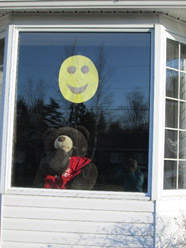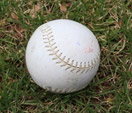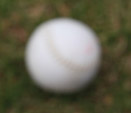 Now that playgrounds are closed, some communities are setting up “eye spy” style scavenger hunts so that children have activities to do while walking through the community and maintaining physical distance from others. Prince Edward Island has started the “PEI Bear Hunt”, where people hang teddy bears in their windows so that kids can spot them as they walk about their neighbourhoods.
Now that playgrounds are closed, some communities are setting up “eye spy” style scavenger hunts so that children have activities to do while walking through the community and maintaining physical distance from others. Prince Edward Island has started the “PEI Bear Hunt”, where people hang teddy bears in their windows so that kids can spot them as they walk about their neighbourhoods.
Children with a visual impairment can participate in this activity and other forms of “Eye Spy” as long as some guidelines are followed. In order to keep it fair, all participants need to keep in mind two things: size, and contrast.
Contrast
High contrast means that something is very different from what is around it, e.g. light on dark. Low contrast means that there is little difference between an object and what is around it, e.g. dark on dark or light on light (e.g. Contrasting colours (like yellow on blue, for example) can also increase contrast provided that an individual does not have colour vision deficiencies. It is easier to spot objects that are of high contrast, so objects chosen in the game should be of high contrast, especially at the beginning.
Size
People who have a reduced visual acuity cannot spot the same level of detail. Distinguishing details may include the shape and location of ears or eyes, the number of feet, or some property of light or shadow that indicates a key identifying feature. For example, a ball can be recognized by its round shape and colour. A soccer ball can be recognized by the distinctive spots on it, and a baseball can be recognized by its swirly stitching (see example below).


A reduced visual acuity may mean that an individual may be able to see the shape of the ball but not any details about its markings or stitching. Accepting “ball” instead of “baseball” as a correct answer in the game will make it fair.
Size decreases with distance and increases as we get closer to objects. Choosing larger and closer objects makes the game fair because everyone has the same chance to identify the chosen object. See the example below:
The image on the left simulates what it is like to have 6/120 visual acuity, or 20/400. The image on the right simulates 6/6 visual acuity, or 20/20.


Being closer to the objects increases their relative size and makes it a bit easier to try to make out what they are:

At a minimum, objects chosen should be larger than an adult pinky finger extended out at arm’s length for someone with a visual acuity of 6/120, but closer or larger is better still. In this example, the identifying features of the ball are its shape, but the identifying features of the other objects are more subtle. One would have to move much closer, until the ears were as large as an adult pinky finger extended at arm’s length to be able to identify the distinctive shape of a cat’s ear. The outline of a dog sitting may be enough of a distinguishing feature to identify at this distance, but it may be necessary to get closer to make out further details in order to identify the object on the right.
So how big is fair?
This can be a confusing question. Use your knowledge of every participant’s visual acuity and the following chart to help figure out what details are fair to “spy” and which are too hard.
| Visual Acuity | Minimum apparent size at 60 cm (24”) | Common object equivalent |
|---|---|---|
| 6/240 (20/800) | 2.5 cm (1 inch) | Width of an adult’s thumb at arm’s length |
| 6/120 (20/400) | 1.3 cm (½ inch) | Width of an adult’s pinky finger at arm’s length |
| 6/60 (20/200) | 0.6 cm (¼ inch) | Approximately the width of an adult’s pinky fingernail at arm’s length |
Children’s arms, thumbs, and fingers are all different sizes, so it might be easier to create an “Eye Spy” wand that kids can wave around to find something to spy that’s bigger than the circle on the wand. The circles below can be cut out and attached to a stick to make an “Eye Spy” wand: